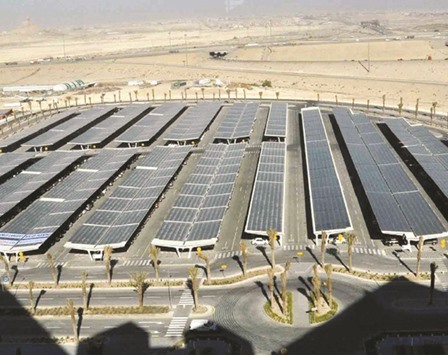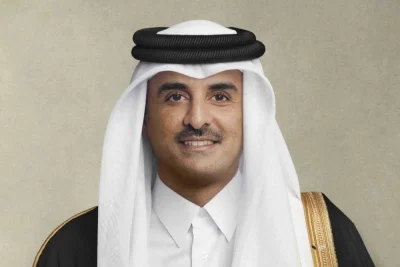The nation most identified with its massive oil reserves is turning to wind and solar to generate power at home and help extend the life of its crucial crude franchise.
Starting this year, Saudi Arabia plans to develop almost 10 gigawatts of renewable energy by 2023, starting with wind and solar plants in its vast north-western desert. The effort could replace the equivalent of 80,000 barrels of oil a day now burned for power. Add in natural gas projects set to start later this decade, and Saudi Arabia could quadruple that number, according to consultant Wood MacKenzie Ltd. That could supplant all the crude burned in the kingdom during its winter months.
The effort goes hand-in-hand with a drive to broaden the economy following two years of budget deficits tied to low oil prices. More industry, though, means more energy, with the amount of power used at peak times growing by 10% in the last year alone.
“Renewable energy is not a luxury anymore,” said Mario Maratheftis, chief economist at Standard Chartered, in an interview. “If domestic use continues like this, eventually the Saudis won’t have spare oil to export.’’
In all, Saudi Arabia is seeking $30bn to $50bn worth of investment in renewables, Energy Minister Khalid al-Falih said this month. The ministry will set up a division to handle the tenders until the country establishes a new independent buyer for all power supplies.
“The terms on renewable contracts will be motivating so that the cost of generating power from these renewable sources will be the lowest in the world,” al-Falih said at a news conference in Riyadh. The kingdom will award its first tenders to build 700 megawatts of solar and wind energy in September, al-Falih said.
The government has already raised domestic energy prices to slow demand growth and called for greater efficiency, according to the Riyadh-based King Abdullah Petroleum Studies and Research Center. Failing to tap more sources, including renewable energy, natural gas or even nuclear reactors could erode the oil exports still vital to the economy, the centre wrote in an October report.
Improving the country’s energy efficiency by just 4% a year could save the equivalent of 1mn bpd of crude by 2030, according to the report.
The cornerstone of an economic transformation plan championed by Deputy Crown Prince Mohammed bin Salman, a son of the king, is the sale of as much as 5% of Saudi Arabian Oil Co. With the company worth about $2tn, according to estimates from the prince, the share sale would be the worlds’ largest initial public offering.
The kingdom, Opec’s biggest member, is the key player of the group’s effort to prop up crude prices by cutting output to reduce a global supply glut. Saudi Arabia said it pared production by 717,600 bpd last month, its biggest cut in more than eight years, to 9.748mn a day, according to a monthly report from the Organization of Petroleum Exporting Countries. The cut was significantly larger than what the country pledged – 486,000 bpd – under the agreement Opec reached in November.
Saudi Aramco, as the state energy producer is known, already earns most of the Gulf kingdom’s income by pumping 1 in every 10 barrels sold every day. It’s also driving the country’s first steps toward a renewable energy industry.
At its sprawling campus of office buildings, control rooms and suburban-style residential compounds in Dhahran in the country’s east, Saudi Aramco runs the country’s biggest solar plant, a 10 megawatt facility mounted on a parking lot roof. In January, it started the kingdom’s first commercial wind turbine to power a facility in the northwest. The solar panels atop the parking facility cut the need for the equivalent of about 30,000 barrels of oil and the wind turbines will eliminate demand for about 19,000 barrels, according to Aramco.
As the kingdom strives to build industries and spread jobs, other state companies are expanding projects. The Saudi Arabian Mining Co operates a phosphate plant and is building a new industrial city in the northwest. Power for sections of the vast area where those projects are located will partly come from renewables and new gas projects.
“Small projects are very important in helping diversify the country’s energy sources,” Stewart Williams, Wood Mackenzie’s vice president for Middle East research said in a telephone interview. “These are steps toward building up the country’s energy base.”
Without alternative power sources, including gas and renewables, the kingdom would be forced to increase its crude burn. That can reach as high as 900,000 bpd during the kingdom’s summer months, according to data from the Joint Organisations Data Initiative.
Saudi Arabia has already taken steps to substitute natural gas for oil in power plants, a change that’s had “immense” impact on the crude burn, Opec said in its Monthly Oil Market Report released in January. The use of crude for domestic power has fallen by nearly a third since the Wasit gas plant began operations in March 2016, according to the Opec report.
Saudi Aramco will bring online the similar-sized Fadhili gas project in the country’s east by the end of the decade. That gas project and the renewable projects planned for completion by 2023 could save about 300,000 barrels of oil from being burnt for power, according to estimates based on IEA and Opec data.
Alternative energies are “a key factor in the economic transformation,’’ Fabio Scacciavillani, chief economist of the Oman Investment Fund, said in an interview. “This region has a great competitive advantage in low-cost energy production and that will continue with renewables. That will create a big advantage particularly in energy intensive industries.’’

At Saudi Aramco’s sprawling campus of office buildings, control rooms and suburban-style residential compounds in Dhahran in the country’s east, Saudi Aramco runs the country’s biggest solar plant, a 10 megawatt facility mounted on a parking lot roof. The solar panels atop the parking facility cut the need for the equivalent of about 30,000 barrels of oil and the wind turbines will eliminate demand for about 19,000 barrels, according to Aramco


